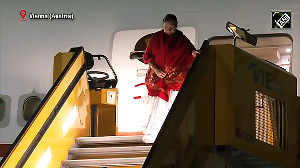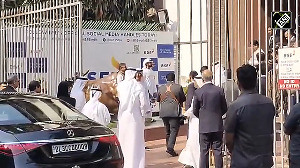There was a clear polarisation of Christian and (especially) Muslim votes in favour of the UDF. This caused enough misgivings to start a consolidation of Hindu votes behind the LDF, says T V R Shenoy.
"I have come to an insane asylum!" Swami Vivekananda reportedly exclaimed after touring Kerala.
My own memories, obviously, do not stretch as far back as 1892 but I can easily recall the time before the reorganisation of states gave Kerala not just its current contours but also its current name, remember back when it was Travancore-Cochin at the dawn of independent India, and even farther back when it was two princely states and a Malabar integrated into the giant British province of Madras.
Delving into 70 years of memories I cannot recollect another time when Kerala was so split on communal lines. Look no farther than the newly-elected Kerala assembly if you want to see proof of that.
If I had to sum it up I might use the abbreviation 'PCM'. In the season of the IIT-JEE results some might mistake that for 'Physics, Chemistry, Maths', and that is true in a sense. (More on that later.)
But it could also easily be shorthand for 'Polarisation of Christians and Muslims' -- inevitably leading to a counter-aggregation of Hindus.
Kerala is still, technically, a state where the majority of the population is Hindu. The data for the 2011 Census are not out but according to the 2001 numbers, 56.2 percent of Keralites were Hindus, 24.3 percent were Muslims, and 19 percent were Christians. Those values have almost certainly changed over the past decade; the 2001 Census also revealed that the Hindu and the Christian figures had fallen since 1991, the Christian population dropping by 0.32 percent and the Hindu population by 1.48 percent.
Assuming, however, that Hindus still constitute about 50 percent you would think the majority community make up roughly half of the assembly. As they, nominally, represent the majority that assumption should be particularly true of the treasury benches.
Wrong. 49 of the 72 MLAs in the ruling United Democratic Front are non-Hindus -- a tad over 68 percent. Contrariwise, only 19 of the 68 MLAs in the Left Democratic Front are non-Hindus -- just under 28 percent.
There was a clear polarisation of Christian and (especially) Muslim votes in favour of the UDF. This caused enough misgivings to start a consolidation of Hindu votes behind the LDF. (And yes, I recognise the irony of Hindus surging behind nominally atheist Marxists but that is the reality of Kerala!)
At this point, I know there are some readers who will whine about journalists writing about 'communal' topics. Spare me the rubbish!
We live in a day where the Manmohan Singh cabinet has approved a caste-based census. This is also a time when, in the wake of the Sachar Committee Report, reservation for Muslims is being openly discussed.
I hope you realise what this means. It was the Congress, at the urging of Mahatma Gandhi, that ensured there would be no separate enumeration of castes in the census after 1931. And the founding fathers of the Republic of India -- memories of where Muslim reservation had led India fresh in their minds -- did not opt for religion-based reservation.
If the Sonia Gandhi-Manmohan Singh duopoly wish to overturn over 60 years of Congress policy let us admit that there will be consequences. Both caste and religion will play increasingly larger roles in public life. Berate it if you like but start getting used to the fact.
The second reason for writing about the make-up of the Kerala assembly is that every section of society in the state is already talking about it -- from mailmen to ministers -- but privately. Nobody wants to come out and admit the obvious, that in a democracy it is deeply flawed to have a government where the majority community is severely under-represented.
It makes for some bad physics, worse chemistry, and some absolutely horrible maths.
The current set-up is bad from the point of view of physics because it is inherently unstable. Ideally, a ministry would be like a pyramid -- resting on a broad base of support. What we have right now is a ministry that is like a spinning top -- narrow at the base and broader above. A top is nice to look at while it works but we all know how it ends -- thrashing about, then toppling over.
Ministries have been given to one-MLA and two-MLA parties because there is no other option. The numbers are so finely balanced that a couple of disgruntled MLAs could topple the Oommen Chandy ministry.
I have already mentioned how skewed the Hindu to non-Hindu ratio is on the treasury benches. But, in the spirit of the caste-based enumeration approved by the Congress high command, it gets even worse when you look at the caste break-up. The Ezhavas, for instance, are numerically the largest Hindu community, and yet they have but three MLAs to represent them on the UDF benches. And soon the Nairs shall start counting how many they have, and then each of the rest.
It makes for rotten chemistry because, as noted above, the Congress is only too aware of the lack of support from Hindus. This has already led to a face-off between the Congress and its principal partners in the UDF before the Chandy ministry was two weeks old.
The Congress has ten representatives in a 20-strong ministry. Since the Congress has only 38 MLAs that is a ratio slightly better than 1:4. The Muslim League (whose name reveals its leanings) and the Kerala Congress (whose name conceals its Christian base) think they should enjoy the same ratio of MLAs to ministers. In other words, the Muslim League thinks itself entitled to five ministerships while the Kerala Congress wants three, one more each than has been allotted.
Panakkad Sayyid Hyder Ali Shihab Thangal, president of the Muslim League, set the cat among the pigeons before the Chandy ministry was a week old. He unilaterally announced the name of Manjalamkuzhi Ali as the candidate for the proposed fifth berth. This may have been either a bid for 'parity' with the Congress, or an attempt to keep the MLA in good temper since he had quit the LDF.
The Kerala Congress is not to be left behind. It has delicately suggested that a ministerial berth for, say, P C George would be welcomed.
It leads to bad chemistry within parties when 'X' gets a ministry and 'Y' does not, particularly so when a 'Y' was once part of another bloc. But trying to settle the chemistry within the Muslim League and the Kerala Congress would lead to a mathematical nightmare for the Congress.
The first difficulty lies with the Ninety-First Amendment. The relevant part reads: "The total number of ministers, including the chief minister, in the council of ministers in a state shall not exceed fifteen percent of the total number of members of the legislative assembly of that state."
Kerala elects 140 MLAs, meaning there cannot be more than 21 ministers. The current cabinet is already 20-strong, so there is no way that both the Muslim League and the Kerala Congress can be satisfied.
Second, consider what happens if the Congress sacrifices one of its own seats to keep the two powerful allies happy. The Muslim League will put up a Muslim and the Kerala Congress shall field a Christian. That will further dilute the Hindu element in the cabinet.
As we all know, the Congress is promoting not just a caste-based census and greater opportunities for Muslims but also gender-based representation. I note without comment that there is exactly one woman MLA in the UDF benches, P K Jayalakshmi.
It used to be said that what Bengal thinks today India shall think tomorrow. When it comes to politics it would be more accurate to say that what Kerala suffers today India must endure tomorrow. Kerala was experimenting with coalition governments long before they took shape in New Delhi -- and Kerala is seeing the effects of communal polarisation on government well before the caste-based and religion-based policies of the UPA regime are felt in India as a whole tomorrow.
Yes, it is disgusting to see so decent and secular (in the noble sense of the word) a man as Chandy immersed in calculating by caste and creed. Get used to it; the policy is set in Delhi, not Thiruvananthapuram.
How might Swami Vivekananda react if he were to return to Kerala today? Perhaps he might say, "The inmates have taken over the asylum!"









 © 2025
© 2025